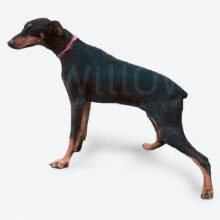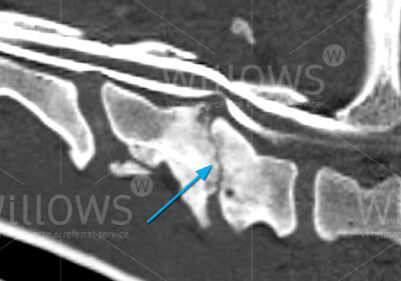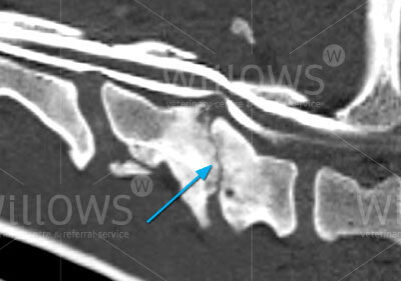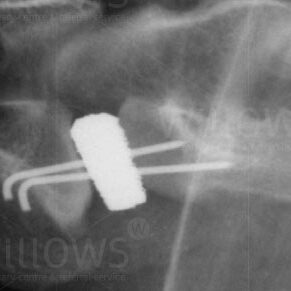Why Should I Bring my Pet to Willows for Cervical Spondylopathy?
Willows is one of Europe’s leading small animal referral centres. Our state-of-the-art hospital is led by internationally renowned Specialists, committed to providing the highest standards of veterinary care. Our team of Specialist Neurosurgeons have extensive experience, having treated hundreds of dogs with cervical spondylopathy, providing gold standard management and treatment for all our patients.
Our Neurosurgeons are supported by our multi-disciplinary team of Specialists across several disciplines including; Anaesthesia, Diagnostic Imaging and Emergency and Critical Care. Willows also has a large dedicated team of Vets, Nurses and clinical support staff available 24 hours a day, every day of the year to provide the best possible care for your pet.
What is Cervical Spondylopathy?
Cervical spondylopathy is an uncommon condition involving abnormal development of the bones in the neck (the cervical vertebrae). A common term for cervical spondylopathy is ‘wobbler syndrome’, due to the characteristic wobbly pattern of walking that many of these dogs develop.
What are the Most Common Causes of Cervical Spondylopathy?
The deformed bones may directly or indirectly (with potential involvement of a ‘slipped disc’) compress the spinal cord. Instability of the abnormal vertebrae may play an important role in the development of the condition.

What are the Signs of Cervical Spondylopathy?
What are the Signs of Cervical Spondylopathy?
Signs of cervical spondylopathy are either due to:
Spinal cord: Compression of the spinal cord causes weakness and lack of coordination. The back legs (hind limbs) tend to be more severely affected than the front legs (fore limbs). Scuffing of the paws and dragging of the toe nails is common. Typically the front legs have a shortened stride with a choppy action and the back legs look disconnected. Inability to walk and incontinence are very common with cervical spondylopathy.
Neck pain: Signs of neck pain may be obvious e.g. yelping and crying or rigidity of the neck. More subtle signs include reluctance to jump or climb and low head carriage. Difficulty lowering the head to eat from the floor may be evident.
Fig 1: Typical Doberman with a wide-based hind limb stance

How is Cervical Spondylopathy Diagnosed?
A neurological examination is necessary to detect evidence of spinal cord compression and neck pain. Following this investigations are necessary to confirm the diagnosis and exclude other conditions.
X-rays of the neck may reveal evidence of cervical disc disease, such as a narrowed disc space or a calcified disc. However, more advanced investigations are necessary to see what is actually compressing the spinal cord and to assess the severity I of the compression. These advanced imaging techniques, include the use of CT after injecting a dye (contrast agent) around the spinal cord (CT- myelography) or an MRI scan.
There are advantages and disadvantages of each technique. The CT-myelography imaging technique provides better information about the bones of the spine (the vertebrae) than an MRI scan but poorer detail of the soft tissues, such as the spinal cord (the nervous tissue). MRI is less invasive than CT myelography with less risk of side-effects.
With either technique the spine can be put in traction (stretched) in order to see if the compression on the spinal cord is reduced or eliminated. This helps identify dogs with cervical spondylopathy associated with a ‘slipped disc’ and assist greatly in deciding the best course of treatment for the individual patient. Both MRI and myelography require the dog to have a general anaesthetic.
Occasionally it is necessary to collect some fluid (cerebrospinal fluid – CSF) from the spine and send it to a laboratory for analysis. This test assists in the diagnosis of inflammatory conditions that affect the spine.

CT-myelogram in a dog showing deformed vertebrae with collapse of the disc space, protrusion of the disc, and spinal cord compression.

MRI scan of a dog with cervical spondylopathy showing deformed bones (vertebrae) and an associated slipped disc with severe spinal cord compression.

How Can Cervical Spondylopathy be Treated?
Many patients are managed surgically to try and prevent further injury to the spinal cord. However, for some older dogs and for those where the outlook with surgery is very poor they may be managed through conservative treatment.
Surgery: The aim of surgery is to relieve the compression on the spinal cord. This may be achieved either by cutting the compressing tissue away from the spinal cord or stretching the abnormal tissue (providing it is soft tissue and not bone) to reduce compression on the spinal cord. Stabilisation (or fusion) of the abnormal vertebrae may be necessary.
Conservative treatment: In dogs with cervical spondylopathy that are undergoing conservative treatment, their exercise should be restricted and avoid unnecessary jumping and climbing. Short walks on a harness may be preferable to long periods of free exercise. Painkillers may be necessary if there are signs of neck pain.
Fig 4: X-ray showing vertebral distraction-stabilisation using a tantalum spinal fusion block

What Can I Expect if my Dog is Treated for Cervical Spondylopathy?
The outlook with cervical spondylopathy can be variable. In severe cases that are managed conservatively, progressive spinal cord compression often results in deterioration in strength and co-ordination. Some dogs become unable to walk. The development of these signs may be gradual or sudden.
The success rate of surgery depends on the nature of the spinal cord compression, the number of areas of compression and whether or not the compression(s) responds to traction. The best scenario is generally a single, traction-responsive, disc related spinal cord compression. In these cases the outlook is often favourable, although a degree of weakness and lack of co-ordination may persist. Unfortunately, with cervical spondylopathy the spinal cord has often been compressed for a long time prior to treatment and this results in some of the nervous tissue injury being irreversible.
To save this page as a PDF, click the button and make sure “Save as PDF” is selected.
Neurology
Find out more
To assist owners in understanding more about Neurological conditions, investigations and treatment we have put together a range of information sheets to talk you through the some of the more common neurological conditions seen by our Specialists.

